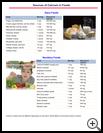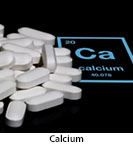
Calcium in Your Child’s Diet
________________________________________________________________________
KEY POINTS
- Calcium is a mineral that is important for your child’s heart, bones, teeth, and muscles to stay healthy.
- Eating or drinking certain things can cause your child to lose calcium.
- Your child can get calcium from dairy products, calcium-fortified foods, or from supplements. If your child gets enough calcium in his diet, he does not need to take calcium supplements.
________________________________________________________________________
What is calcium?
Calcium is a mineral that is very important for:
- Bone health
- Teeth
- Nerves
- Muscles
- Blood clotting
Most of the stored calcium for bone strength is laid down by age 17. Helping your children get into the habit of eating calcium-rich foods decreases their risk for weak bones later in life.
How much calcium does my child need?
Many food products list the amount of calcium per serving on the box. Food labels list calcium as a % of the Daily Value (DV) based on 1,000 mg of calcium per day. Look for foods that provide 10% or more of the daily value for calcium.
The amount of calcium your child needs depends on age:
Group Calcium/Day -------------------------------------- Children 1 to 3 700 mg Children 4 to 8 1000 mg Children 9 to 18 1300 mg -------------------------------------- * mg = milligrams
Milk products are one of the best sources of calcium. Calcium is also in many other foods, but if milk products are not a part of your child’s diet, it may be hard to get enough calcium from the foods your child eats. The calcium in vegetables, beans, and soy, is not absorbed as well as the calcium in milk products. Here are examples of how much milk your child should have at different ages:
1 to 3 years old
- About 2 to 2 and 1/2 cups of whole milk (700 mg of calcium) per day. Children 2 years of age and older can start drinking low-fat or non-fat milk.
4 to 8 years old
- About 3 to 3 and 1/2 cups of fat free or low-fat milk (1000 mg of calcium) per day
9 to 18 years old
- About 4 to 4 and 1/2 cups of fat free or low-fat milk (1300 mg of calcium) per day
The calcium in 1 cup of milk is the same amount of calcium as 1 cup of yogurt, 1 and 1/2 ounces of cheese, or 2 ounces of processed cheese.
Children from 1 through 18 years of age should get 600 IU of vitamin D per day. Vitamin D helps the body absorb calcium.
What keeps my child from getting enough calcium?
Here are some things that can make it harder for your child’s body to get enough calcium:
- Not getting enough vitamin D. Vitamin D increases the amount of calcium absorbed by the body. It’s important to get enough sunlight to help the body make vitamin D and to choose foods that contain vitamin D. Milk contains vitamin D and some brands of cheese, yogurt, juice, and margarine have added vitamin D. Check labels for the amount of vitamin D per serving. Fish such as salmon, mackerel, and tuna are good natural sources of vitamin D. If your provider recommends that your child take a calcium supplement, there are some that include vitamin D.
- Too much fiber in the diet. This is more of a concern if your child has low amounts of calcium in his diet. Your child should take calcium supplements or eat calcium-fortified foods 2 hours before or after eating 100% bran products. Soaking beans in water and discarding the liquid before cooking can also help.
- Soft drinks, energy drinks, tea, and coffee. Children and teens who drink these products instead of milk often don't get enough calcium.
- Taking some medicines. Medicines such as some antibiotics, heartburn medicines that decrease stomach acid production, and antacids that contain aluminum can make it harder for your child’s body to absorb calcium.
These things can cause the body to lose calcium:
- Eating a lot of protein foods, such as meats, poultry, and eggs. The more protein your child eats, the more calcium he can lose. As long as your child’s diet is balanced and contains enough calcium, this should not be a problem.
- Eating a lot of salt. The more salt in your child’s diet, the more calcium your child loses. Limit the salt in your child’s diet. Cutting back on salt and getting enough calcium can help lower blood pressure and help prevent fluid retention.
Does my child need a calcium supplement?
If your child gets enough calcium in his diet, he does not need to take calcium supplements. Your child is more likely to need a supplement if he:
- Has digestive problems that prevents him from absorbing nutrients like calcium.
- Avoids dairy products due to allergic or other reactions (such as lactose intolerance or milk allergy).
- Doesn't eat any animal products.
- Does not get enough calcium in his diet.
- Has osteopenia (weakened bones).
- Has a vitamin D deficiency.
If your child takes calcium supplements and eats a lot of calcium-fortified foods, he may get too much. Ask your healthcare provider or dietitian if your child should take a calcium supplement, and which kind to should take.
There are many kinds of calcium supplements. The most common are calcium carbonate and calcium citrate.
- Calcium carbonate is best absorbed with a meal.
- Calcium citrate can be taken on a full or empty stomach. Calcium citrate may be a better choice for younger people who have low levels of stomach acid.
- Calcium phosphate, lactate, and gluconate are also well absorbed. However, the amount of calcium per pill is lower, so your child may need to take many pills a day to meet his needs.
Your child’s body absorbs calcium best if he takes no more than 500 mg at a time, and takes it two or more times per day as recommended by your healthcare provider. Look for calcium supplements that have the USP or Consumer Lab symbol on the label. Products with these labels have been tested to make sure they are absorbed by the body.
How can my child eat the right amount of calcium?
Eat more calcium-rich foods. Here are some ideas for adding calcium to your family's diet.
- Have low-fat or nonfat milk, cottage cheese with fruit, or yogurt for snacks.
- Eat calcium-fortified breakfast cereals with rice, almond, or soy milk, or have calcium-fortified waffles or pancakes.
- Cook hot cereals with milk instead of water.
- Serve yogurt or milk smoothies instead of juice.
- Add yogurt to lunches or use yogurt as a dip when having a fruit snack.
- Add shredded cheese to baked potatoes, vegetables, soups, and salads.
- Use milk when making cream soups instead of water.
- Serve flavored milk or hot chocolate for an evening treat.
- Use Parmesan cheese topping for Italian dishes. A 2 tablespoon serving adds about 140 mg of calcium.
- Serve a healthy vegetable pizza made with low-fat cheese.
- Serve lean mozzarella string cheese with crackers and fruit for a snack.
- Make puddings with milk.
- Make sure that your child stays physically active as advised by your child’s provider. Exercise helps your child’s body to use calcium to strengthen bones.
Some children cannot digest most milk products because their bodies lack the enzyme needed to break down milk sugar. This problem is called lactose intolerance. If your child has this problem, you can buy products such as Lactaid or Dairy Ease. Talk with your healthcare provider about this.
For more information contact:
- The Academy of Nutrition and Dietetics
800-366-1655
http://www.eatright.org
Last modified: 2017-04-10
Last reviewed: 2017-04-10


